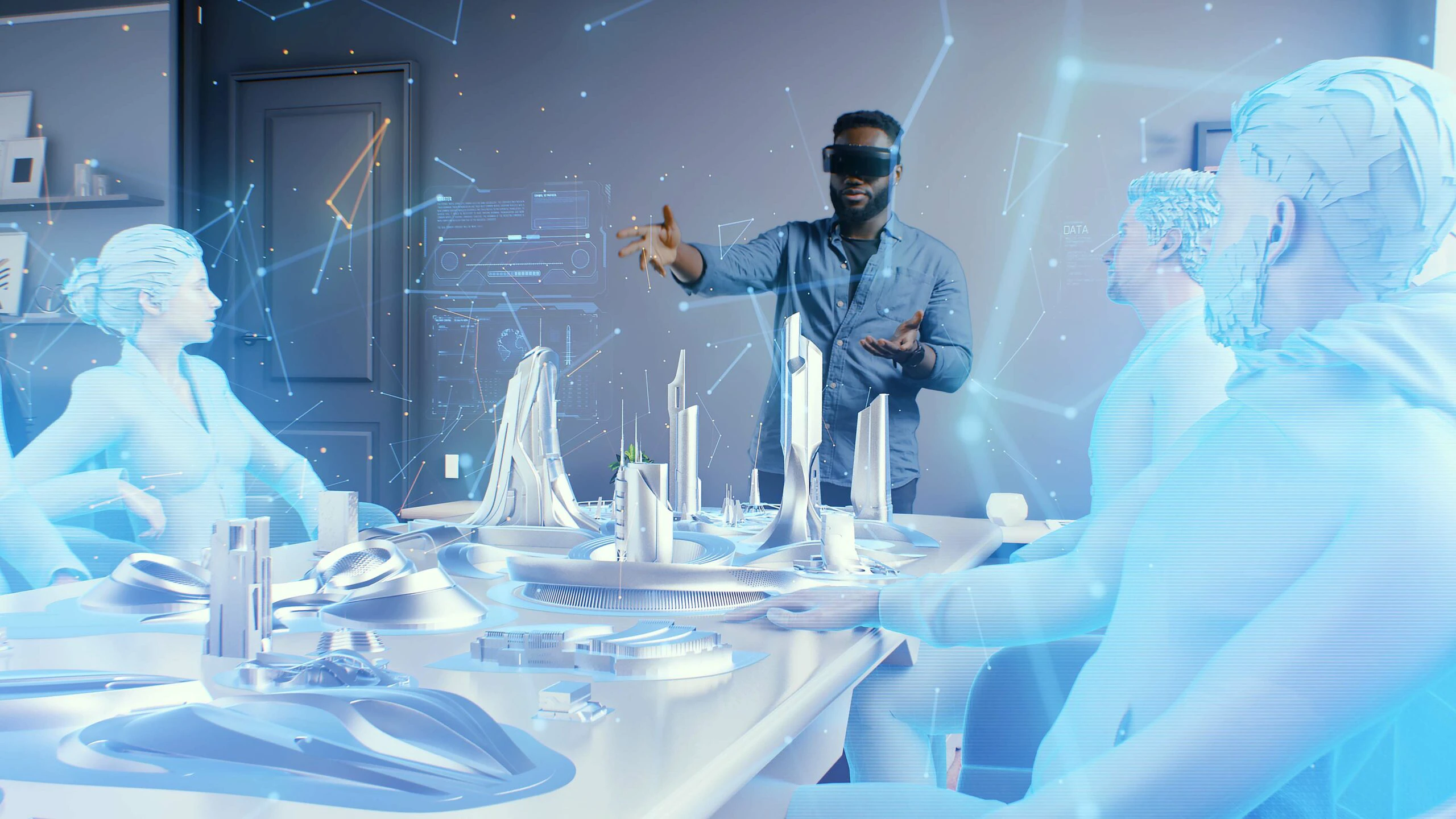
5 Steps To Create An XR Workflow That Incorporates Generative AI 3D Models
Creating effective XR training experiences using 3D environments requires a meticulous approach to XR workflow. That’s especially true if you want to leverage the capabilities of AI tools such as the Midjourney AI pipeline and Adobe Photoshop Content-Aware Fill. Creating an effective virtual reality course has never been more within reach.
As a Learning Strategy Consultant at The Learning Network, I’ve been involved in developing learning experiences leveraging both machine learning and extended reality (XR) for over 20 years. I’ve evolved and expanded my knowledge and practice in these fields as the technology progresses.
In this article, I’ll guide you through the process of deciding whether AI tools are right for you, developing a workflow to accommodate them if the answer is “yes,” and assigning the right people in your organization to help bring those 3D environments used in XR trainings to life.
Step 1: Evaluate Your Learning Objectives To Decide If Generative AI Can Help Your XR Workflow
Integrating AI tools into your XR workflow requires careful alignment with learning objectives. I recommend that businesses follow these steps to determine whether tools such as Midjourney and Adobe Photoshop Content-Aware Fill are right for them:
- Define Objectives: Clearly outline the learning outcomes you want to achieve.
- Identify AI Tools: Explore AI tools that enhance those objectives. Generative AI can create 3D models from text inputs, while conversational AI facilitates natural language interactions.
- Evaluate Effectiveness: Assess how AI tools impact learning outcomes, engagement, and ethical considerations.
If you work through these steps and conclude that generative AI could enhance learning objectives and deliver the kind of 3D environments you need to build for your next virtual reality course, the next step is to understand specific tools in greater detail.
Step 2: Understanding Midjourney And Adobe Photoshop Content-Aware Fill
These two popular tools are especially relevant for developing generative AI 3D models used in XR workflow and corresponding training environments. For decision-makers unfamiliar with these tools, let’s briefly delve into them:
- Midjourney: This Discord-based tool utilizes AI to generate 3D images from text prompts. Through simple chat interactions, you can request images like “a line haul truck” or “a sunny day at the beach.” Midjourney produces four images, which can be refined and modified using commands. You can use it as a concept tool—to explore various ideas and variations early in the design process—or as a reference tool later in the process to gain inspiration and guidance for your own 3D models and textures.
- Adobe Photoshop Content-Aware Fill: This feature in Adobe Photoshop removes objects from images by automatically filling the space with sampled content. It streamlines the image editing process, making it ideal for refining 3D environments. Use it to remove unwanted elements from images or textures, ensuring a clean and suitable appearance. It can also support rendering, filling in missing areas or gaps in the final output to enhance the overall visual appeal of your learning environment.
These tools possess the potential to reshape 3D environment design within businesses and their virtual reality course materials, democratizing the process of XR training development, and saving resources.
Step 3: Determine How Much Realism Your Training Requires
Achieving realism is a crucial consideration when incorporating generative AI 3D models into your XR environment via your XR workflow. However, the level of realism needed varies based on your training goals. For instance:
- Learning Objectives: Align the environment’s detail level with the learning objectives to ensure effectiveness.
- Task-Specific Training: For skill development, focusing on relevant environmental aspects can be sufficient.
- Contextual Realism: Replicating the overall context of a scenario might be more important than intricate details.
- High Fidelity: In sectors like medicine or equipment maintenance, high-fidelity simulations are vital for precision.
Before you design a single environment, you need to decide on an approach to balance realism and learning objectives. This ensures that your XR training environment effectively enhances skills while leveraging the immersive potential of 3D technology.
For example, stylized or cartoony visuals might help enhance affective domain learning such as when portraying humorous scenarios or sharing conceptual content. Meanwhile, simplifying can be a means of drawing attention to learning objectives, increasing the universality of content, boosting performance on low-spec platforms, and reducing costs.
You can always adapt your approach as you learn more and deepen your skill set when building a virtual reality course or other XR trainings.
Step 4: Develop A High-Level Workflow For Building 3D Environments Used In XR Training
To know when and where to integrate AI tools into your business, it’s important to have a high-level workflow for generative AI 3D models. Here is a common framework I recommend to organizations getting started with generative AI tools:
- Project Scope: Define the project’s scope and objectives, including the target audience and desired outcomes.
- Conceptualization: Brainstorm ideas, create mood boards, and collaborate with stakeholders.
- Storyboarding: Visualize the environment’s key scenes and interactions.
- Asset Creation: Develop 3D assets and animations.
- Environment Design: Set up the layout, arrangement, and virtual positioning of objects.
- Lighting and Rendering: Configure lighting for desired visual quality.
- Asset Integration: Accurate real-world positioning of objects within the environment.
- Texturing and Materials: Apply textures and materials for realism.
- Interaction and Navigation: Implement user interactions and navigation.
- Testing and Iteration: Test and refine the environment based on feedback from employees piloting the space you’re building.
- Optimization: Optimize your learning environment for performance and efficiency.
- Documentation: Document design decisions and technical details.
- User Testing: Gather user feedback for refinement.
- Finalization: Make necessary adjustments and prepare for deployment.
- Post-Development Support: Provide ongoing maintenance and updates.
Integrating AI into this type of XR workflow can enhance your team’s efficiency and creativity and support intricate design. However, human expertise remains essential to ensure that AI-generated elements align with your objectives.
Step 5: Decide Who Should Participate In Your Organization’s 3D Environment Workflows
Now, your workflow for generative AI 3D models is designed. You’ve determined how to best use generative AI tools within it. It’s time to assign specific people to carry out the tasks needed to build the XR training environment such as for a virtual reality course. To ensure a well-rounded perspective and effective training environment, consider involving the following roles:
- 3D Designers And Artists: These professionals are essential for creating visually appealing and immersive 3D assets.
- AI/Machine Learning Specialists: These specialists play a crucial role in integrating AI tools such as Midjourney and Adobe’s content-aware tools into the workflow effectively.
- Content Creators: Writers and content creators ensure that the narrative and information within the 3D environment align with the training goals.
- Data Analysts: Data experts can help analyze user interactions and feedback to further refine the environment’s effectiveness.
- Game Designers: Their expertise in interactive design can elevate user engagement and interaction within the 3D environment.
- Software Developers: Developers bring the technical expertise needed to implement and integrate AI tools and create functional XR experiences.
- Stakeholders And Decision-Makers: Involving decision-makers ensures that the project stays aligned with overall business objectives.
- Subject Matter Experts: Domain experts provide crucial insights into the accuracy and realism required for effective training experiences.
- UX/UI Designers: User experience and user interface designers ensure the environment is intuitive and user-friendly.
By forming a diverse team that covers these areas of expertise, you can ensure a holistic and successful approach to designing 3D environment workflows. You can apply this to each virtual reality course or other types of XR trainings your business offers.
Your Business Can Enhance XR Training With AI-Generated 3D Models
Embracing AI tools such as the Midjourney AI pipeline and Adobe Photoshop Content-Aware Fill can revolutionize your organization’s approach to designing 3D environments used in XR trainings. These tools, when integrated strategically, offer the potential to streamline design processes, enhance realism through generative AI 3D models, and deliver engaging and effective XR training experiences.
A strategy driven by educational objectives, a solid workflow, and clearly defined roles make all the difference.
Leave a comment
You must be logged in to post a comment.

